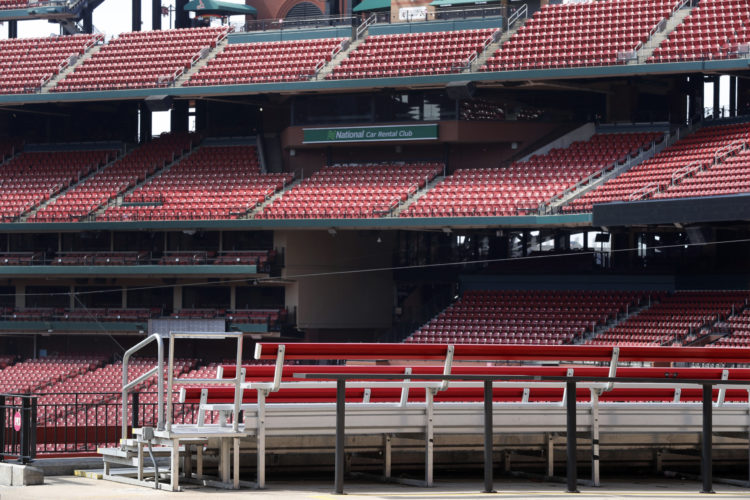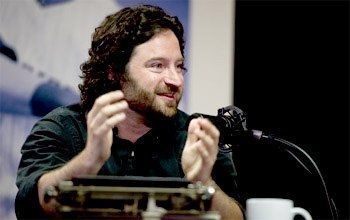
Busch Stadium, home of the St. Louis Cardinals baseball team, stands empty on March 25, 2020, after the coronavirus shutdown cancelled most of this year's season. A shortened "spring" training is set to begin July 1, with a limited 60-game season starting in late July.

St. Louis Post-Dispatch sports columnist Ben Hochman
Fresh out of earning his journalism degree from the University of Missouri in 2002, Hochman was covering the Tulane Green Wave and the New Orleans Pelicans for the New Orleans Times-Picayne when Katrina slammed into the city in 2005. He had no experience reporting during a crisis, and had never taken a class on trauma reporting. Katrina provided that education and, Hochman said, taught him how to approach natural disasters or deadly diseases through the scope of sports without glossing over the harsh realities or dismissing the role of emergency workers on the front lines.
Now COVID-19 has interrupted the usual season rhythm of sports, whether professional, collegiate or amateur. As games are suspended and athletes sidelined, sports journalists have had to sharpen their enterprise muscles to find stories that are engaging and relevant.
Collecting experience, sources and story ideas
Hochman went from New Orleans to Denver before coming home to St. Louis in 2015, where he covers sports for the St. Louis Post-Dispatch. Despite the disruption of the coronavirus pandemic, he has been expected to produce the same number of stories as he did before. But this spring, his editor told him he could relax about length limits.
To make that work, Hochman has relied on three things:
- a list of story ideas that he has build throughout his career
- a large network of sources
- experience adjusting to the moment
The latter is where his on-the-job training in New Orleans serves him well. Hochman said he learned how to ask questions in a compassionate and sensitive way that helps sources share their true emotions and thoughts, rather than speak in predictable soundbites.
“Journalists are in the business of getting the right quotes and true emotion from the people we’re interviewing,” he told me when we talked over Zoom. “And they’re not just necessarily going to give it to us. So, it’s up to me to be compassionate and thoughtful to what they’re going through. That makes them more willing to reveal their true thoughts.”
Hochman also has reached deep into his list of story ideas. He keeps a file on his computer of more than 50 story ideas that he might want to pursue someday. Building a file of dream stories helps him prioritize and organize his ideas, and be respond to the unexpected — the the shutdown of sporting events.
“If I have a story idea but I can’t do tomorrow, I get on this story ideas document,” he said. “I just keep it on there, and then years later, months later, days later, I can go back and like, ‘Ooh, this might be a good one for Thursday’s paper.’”
Finding sources in quarantine has also been hard, but Hochman has stored hundreds of names over the years, too. He as saved contacts, and taps them for new stories. If he needs to reach someone who’s not in his stored file, he will message them on four or five different social media platforms, or send out a tweet asking for perspective on a topic he’s writing about. And sometimes, he said, readers surprise him by sending him emails suggesting stories.
Sports as distraction, therapy and lens
Hochman’s approach has led to multiple placements in the top 10 of (APSE) Associated Press Sports Editors. Many of his stories in recent months have been about how the sports world is being change by the pandemic. He launched a series called “What I miss about sports,” writing about aspects of sports that were overlooked when seasons and scores took up his time. He said he actually has more freedom now to stretch with his writing, like inserting himself into his columns or viewing the larger ravages of coronavirus through the prism of sports.
Following sports can be almost therapeutic for fans, he said, especially in places like St. Louis where people are fiercely loyal to their professional teams. That’s what he experienced when he was still a college student and watched baseball in the weeks after 9/11. Then, having to find relevant sports stories in the immediate aftermath of Hurricane Katrina, he gained a new understanding of the role sports plays in American culture while recognizing the more vital role of journalism that focuses on the emergency response to crises and even, sometimes, to politics.
“Some of my columns are nice escapes or some make you think or whatever,” he said. “But compared to the actual news that reporters are getting; my stuff is just a footnote.”
Hochman also offered a short list of other writers he follows for inspiration and learning:
- Taffy Brodesser-Akner, New York Times. She writes the hell out of a profile.
- Steve Rushin, Sports Illustrated. I love getting lost in old Steve Rushin stories.
- Sally Jenkins, Washington Post. Power in her pen. Thoughtful and unapologetic.
- Jerry Brewer, Washington Post. Fascinating perspectives on sports topics.
- Tom Verducci, Sports Illustrated. Every at-bat for him is an extra-base hit.
Reid Glenn is a senior at the University of Missouri studying sports journalism. He writes for The Columbia Missourian covering the Missouri Tigers and area high schools. Reid plans on graduating in the spring of 2021.
